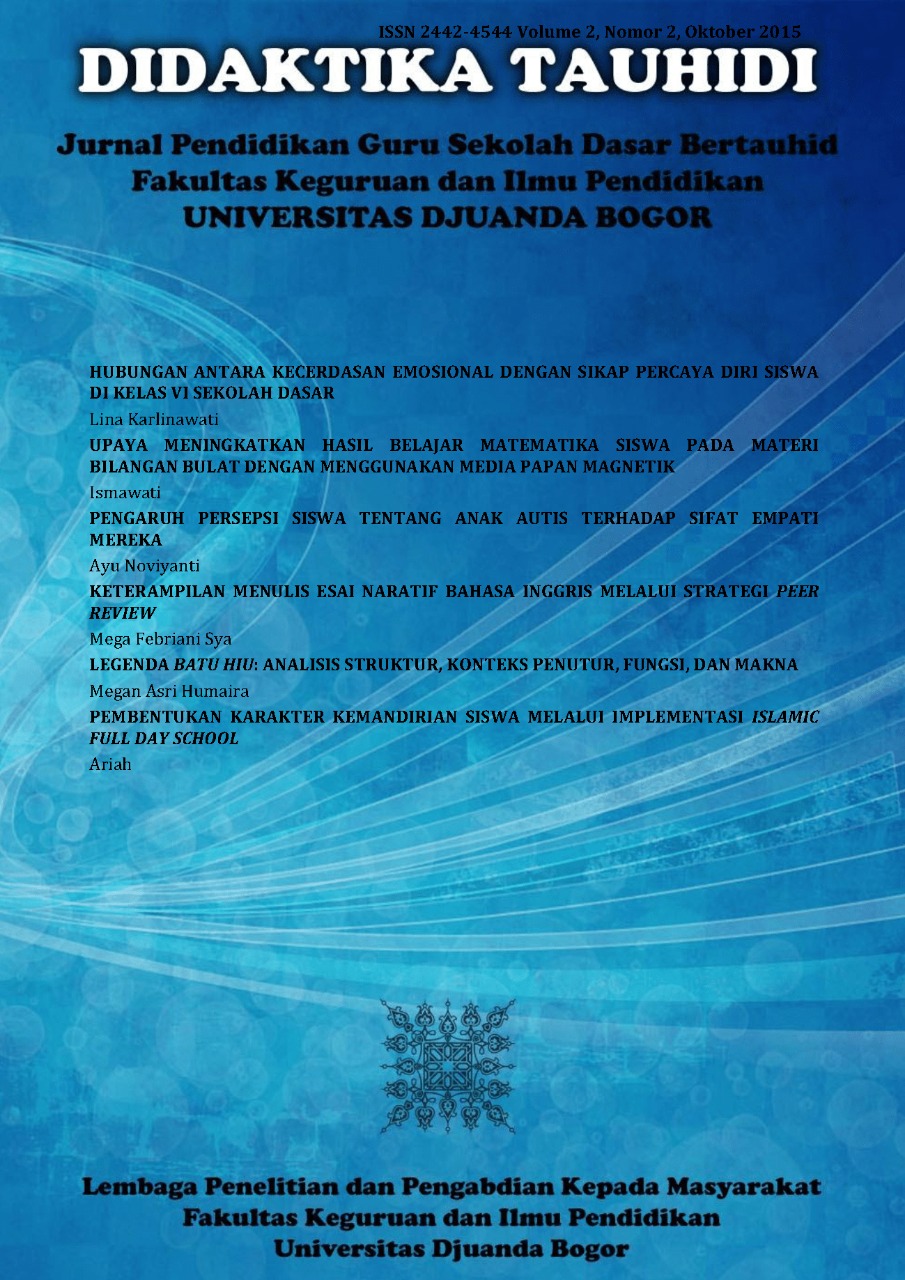HUBUNGAN ANTARA KECERDASAN EMOSIONAL DENGAN SIKAP PERCAYA DIRI SISWA DI KELAS VI SEKOLAH DASAR
Main Article Content
Abstract
Penelitian koresional ini bertujuan untuk mendeskripsikan hubungan antara kecerdasan emosional dan sikap percaya diri siswa SDN Cimpaeun I, Kecamatan Tapos, Kota Depok. Populasi dalam penelitian ini adalah seluruh siswa kelas VI SD berjumlah 360 siswa dan sampel penelitian adalah siswa kelas VI A berjumlah 35 siswa yang dipilih secara acak (random sampling). Berdasarkan hasil perhitungan koefisien korelasi antara variabel X (kecerdasan emosional siswa) dan variabel Y (rasa percaya diri siswa) diperoleh rxy sebesar 0,591. Koefisien korelasi tersebut apabila kita lihat pada tabel tingkat keeratan di atas ada pada kategori hubungan cukup kuat karena terletak antara 0,40- 0,599. Dengan demikian, dapat disimpulkan bahwa tingkat keeratan variabel kecerdasan emosional siswa dengan variabel rasa percaya diri siswa adalah cukup kuat. Tabel model summary menunjukkan hasil KP = R Square x 100% = 0,350 x 100% = 35,0%. Hal ini menyatakan kecerdasan emosional memberikan kontribusi dengan rasa percaya diri siswa sebesar 35% atau dapat disimpulkan rasa percaya diri siswa berhubungan dengan kecerdasan emosional 35%, sedangkan sisanya 65 % dipengaruhi oleh faktor lain yang tidak disebut dalam penelitian ini.
Kata kunci: kecerdasan emosional, sikap percaya diri.
THE RELATIONSHIP BETWEEN EMOTIONAL INTELLIGENCE WITH ATTITUDE OF CONFIDENCE IN CLASS VI PRIMARY SCHOOL
Abstract
This correlational research aimed to describe the relationship between emotional intelligence and confident attitude of students SDN Cimpaeun I Tapos Depok subdistrict. The population in this research across six graders numbered 360 students and the study sample is graders VI A numbered 35 students randomly selected. Based on the calculation of correlation coefficient between variables X (student emotional intelligence) and variable Y (confidence students) obtained rxy 0,591. The correlation coefficient if we look at the table at the top level of closeness is in the category of relationship is strong enough that lies between 0,40 to 0,599. It can be concluded that the level of closeness students with emotional intelligence variable confidence students are strong enough. Model Summary table shows the results KPH = R Square x 100% = 0,35 x 100% = 35%. This suggests emotional intelligence contributes to the confidence of students by 35% or can be inferred confidence associated with the students' emotional intelligence 35% while the remaining 65% are influenced by other factors not mentioned in the research.
Article Details
1. PROPOSED POLICY FOR JOURNALS THAT OFFER OPEN ACCESS
Authors who publish with this journal agree to the following terms:
- Authors retain copyright and grant the journal right of first publication with the work simultaneously licensed under a Creative Commons Attribution License that allows others to share the work with an acknowledgement of the work's authorship and initial publication in this journal.
- Authors are able to enter into separate, additional contractual arrangements for the non-exclusive distribution of the journal's published version of the work (e.g., post it to an institutional repository or publish it in a book), with an acknowledgement of its initial publication in this journal.
- Authors are permitted and encouraged to post their work online (e.g., in institutional repositories or on their website) prior to and during the submission process, as it can lead to productive exchanges, as well as earlier and greater citation of published work (See The Effect of Open Access).
2. PROPOSED POLICY FOR JOURNALS THAT OFFER DELAYED OPEN ACCESS
Authors who publish with this journal agree to the following terms:
- Authors retain copyright and grant the journal right of first publication, with the work [SPECIFY PERIOD OF TIME] after publication simultaneously licensed under a Creative Commons Attribution License that allows others to share the work with an acknowledgement of the work's authorship and initial publication in this journal.
- Authors are able to enter into separate, additional contractual arrangements for the non-exclusive distribution of the journal's published version of the work (e.g., post it to an institutional repository or publish it in a book), with an acknowledgement of its initial publication in this journal.
- Authors are permitted and encouraged to post their work online (e.g., in institutional repositories or on their website) prior to and during the submission process, as it can lead to productive exchanges, as well as earlier and greater citation of published work (See The Effect of Open Access).

References
Fatimah E. 2006. Psikologi perkembangan. Pustaka Setia, Bandung.
Goleman D. 1945. Emotional intelegent. Gramedia Pustaka Utama, Jakarta.
Sugiyono. 2008. Metode penelitian pendidikan pendekatan kuantitatif, kualitatif, dan R&D. Alfabeta, Bandung.
Susanto A. 2013. Teori belajar dan pembelajaran di Sekolah Dasar. Prenada Media Group, Jakarta.

